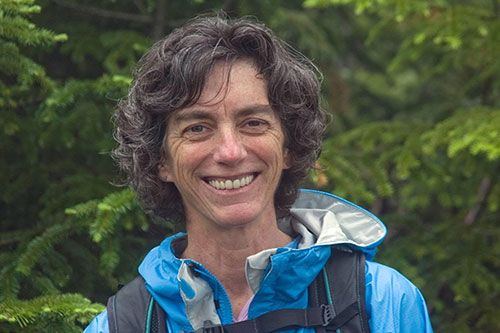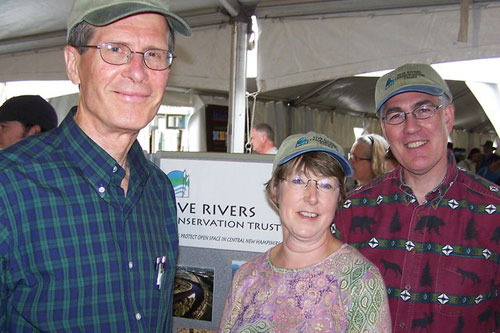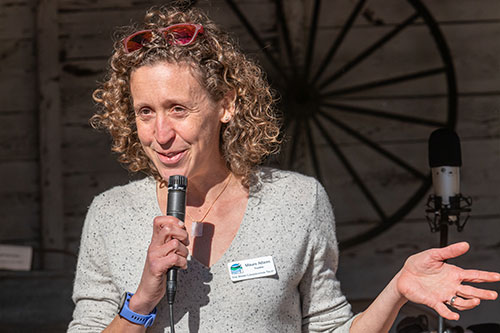Five Rivers Celebrates Women’s History Month
Article by Sarah McCraw Crow and Kathy Barnes
March is Women’s History Month. Five Rivers has a long history of empowering women in important roles, and so in honor of Women’s History Month we are focusing on three women – Jan McClure, Melinda Gehris, and Maura Adams.
Jan McClure: Five Rivers Beginning

Jan McClure
“In the 1980’s, the importance of land conservation was not in the forefront as it is now,” says Jan McClure, one of the founders of Concord Conservation Trust (Five Rivers’ original name). But the prospect of losing a big chunk of Concord’s undeveloped land led to the beginning of Five Rivers, as well as a new era for conservation in the Capital region. That’s because in 1986, Vermont developer Barry Stem bought 800 acres of undeveloped land in East Concord called Broken Ground, planning to build a resort-like destination, including an 18-hole Jack Nicklaus golf course, clubhouse, tennis courts, and 420 housing units.
“The idea that someone could come in and develop one of our prime Concord conservation priorities was a wake-up call,” Jan says. “We realized that we needed a private entity to be able to step in and act quickly, a vital land trust presence that could partner with the City’s Conservation Commission and Planning Board.”
A small group banded together to create a land trust (along with Jan, other early organizers included Suzanne Smith Meyer, Sylvia Bates, Tom Masland, Steve Blackmer, Randy Raymond, and Mary Susan Leahy). Their first efforts were a leap of faith, Jan notes, because there was much less general knowledge about land trusts in the ‘80s.
By the next year, this group had formed a legal entity, Concord Conservation Trust, and was working on outreach and education. “We had two or three projects that were perking along, and the City referred other projects to us,” Jan says. “Right away we tried to publicize our work and build our membership.”
Jan, whose background prior to the formation of Concord Conservation Trust had been working as conservation trust director at the Forest Society, brought her skills to the trust’s board. She served on the board for its first nine years, helping to hire its first part-time executive director and later expanding the organization’s geographical footprint and changing its name to Five Rivers Conservation Trust. When asked to reflect on the growth and success of Five Rivers over these past 30-plus years, she says, “It all tells me is that it was a good idea! Obviously other people thought it was a great idea, too, and joined the effort and made Five Rivers bigger and better.”
Melinda Gehris: Five Rivers Growth

Melinda with fellow board members Rob Knight (left) and Tim Britain (right)
During her tenure as board chair (2011-2013), Melinda Gehris oversaw Five Rivers’ next phase of growth. When Melinda, a lawyer living in Hillsborough, joined the board, the number of Five Rivers-conserved properties was expanding dramatically, thanks to the leadership of Mark Zankel, Tom Irwin, Ken Stern, and Rob Knight. “We were conserving a lot more acres and we were starting to be very methodical about how we did it,” Melinda says. “We became much more proactive in looking at where we wanted to conserve, and how we wanted to spend our resources and energy doing it.”
Five Rivers had also grown to the point where it needed a full-time executive director, Melinda says. “We needed to raise the money for that. Robyn Cotton joined the board, which was fantastic because she’s a development specialist.” With Robyn’s help, Five Rivers created a development plan, built the Conservation Leaders Society, and hosted two well-attended fundraisers at Dimond Hill. “Those fundraisers were a lot of work, but were also a lot of fun and raised a lot of money. And they gave us visibility in a way that nothing else did,” Melinda says.
Under Melinda’s leadership, Five Rivers began the process of gaining accreditation from the Land Trust Accreditation Alliance. (Accreditation is a lengthy, rigorous process, awarded to land trusts that meet the highest national standards for excellence and conservation permanence.) She credits other board members like Ken Stern and Rob Knight for their expertise and hard work on accreditation. “It was a great accomplishment, and it left the organization in a much better place,” she says.
Maura Adams: Five Rivers Today

Maura Adams
Five Rivers’ current board chair is Maura Adams, who in her day job leads Northern Forest Center’s community investment program. Maura joined the Five Rivers board in 2017. After a year on the board, then-chair Richard Head asked Maura to serve as vice chair. “So I agreed. I didn’t entirely know what the role would entail, but I’m glad I said yes, even though it has been challenging at times.”
One of those challenges came during Maura’s third year on the board (and first year as board chair), when Beth McGuinn stepped down as executive director. Maura notes that “sometimes a big change can be disruptive to an organization and lead to setbacks, especially when the executive director is well-regarded and well known to donors. But it was a very smooth transition and that’s something I’m very proud of. And the Board feels thrilled that we found someone so talented and who is embracing the role so incredibly well (Liz Short, the current executive director).”
Five Rivers has had additional staff changes in the past year: Lily Evans was hired as the development and communications coordinator, and Jeff Evans (no relationship) as director of conservation. “Liz being able to assemble this team is just awesome,” says Maura.
Maura is also a trail runner, which has given her a good view of Five Rivers trails. The City of Concord recently added a trail on a Five Rivers property (Backwoods) near Winant Park and Swope Park, she notes. “I was running on the Backwoods trail just the other day, and felt excited and proud to be part of an organization that makes possible having so much conserved land right next to downtown. In most places, that land would be long gone,” she says. “I’ve seen the partnership between the City and Five Rivers grow, and that is an incredible asset to the people around the Capital region and to the environment. That’s the reality of what we are doing. This is about land and people’s love for it.”


